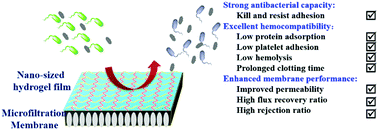A substrate-independent ultrathin hydrogel film as an antifouling and antibacterial layer for a microfiltration membrane anchored via a layer-by-layer thiol–ene click reaction†
Abstract
Herein, a substrate-independent ultrathin hydrogel film was constructed on a microfiltration membrane through layer-by-layer (LbL) thiol–ene click chemistry to improve the antifouling and antibacterial properties. In our strategy, ene-functionalized dopamine was synthesized and coated onto a model substrate (polyethersulfone membrane) to introduce double bonds as anchoring sites for the hydrogel film; thiol-functionalized poly[oligo(ethylene glycol)mercaptosuccinate] (POEGMS) and ene-functionalized P(SBMA-co-AA) were synthesized as hydrogel precursors. The membrane was alternately immersed in the precursor solutions to form the ultrathin hydrogel film. Finally, Ag nanoparticles (AgNPs) were loaded into the hydrogel layer by adsorption and reduction procedures. By coating the hydrogel films, the loaded AgNPs could kill almost all the contacting bacteria and the bacteria in the surroundings, and the enhanced hydrophilicity of the modified membrane could effectively prevent the attachment of the bacteria. The membrane flux showed no significant decrease, the rejection ratio of BSA increased from 51% to 89%, and the FRR increased from 36% to 90%. Moreover, the improvement of the hemocompatibility was confirmed by the decline in the plasma protein adsorption, prolonged clotting times, low hemolysis ratio, and prevention of platelet adhesion. Compared with that of other techniques for attaching hydrogel films, the main advantage of the current technique is that the hydrogel film thickness could be well controlled within the nanometer range; thus, it could significantly improve the antifouling and antibacterial properties of the membrane, but without compromising its permeability. Another advantage is that it is versatile for various substrates such as PVDF, PAN, and CA. This study opens up a facile and versatile route for anchoring ultrathin hydrogel film onto polymeric membranes to achieve excellent antifouling, antibacterial and hemocompatible properties.



 Please wait while we load your content...
Please wait while we load your content...